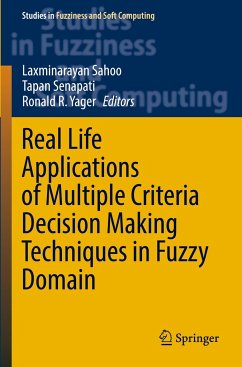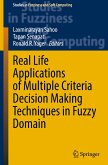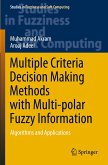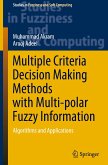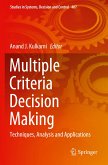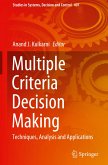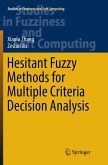Real Life Applications of Multiple Criteria Decision Making Techniques in Fuzzy Domain
Herausgegeben:Sahoo, Laxminarayan; Senapati, Tapan; Yager, Ronald R.
Real Life Applications of Multiple Criteria Decision Making Techniques in Fuzzy Domain
Herausgegeben:Sahoo, Laxminarayan; Senapati, Tapan; Yager, Ronald R.
- Broschiertes Buch
- Merkliste
- Auf die Merkliste
- Bewerten Bewerten
- Teilen
- Produkt teilen
- Produkterinnerung
- Produkterinnerung
This edited book discusses creative and recent developments of fuzzy systems and its real-life applications of multiple criteria decision making. Keeping on the existing fuzzy sets and recent developed fuzzy sets, viz., intuitionistic fuzzy, Pythagorean fuzzy, Fermatean fuzzy, Hesitant fuzzy and multiple criteria decision approaches, this book is committed to probing the soft computing techniques and fuzzy multiple criteria decision making in favour of fuzzy intelligent system and business analytics. It also addresses novel development of fuzzy set theory as well as real-life applications of…mehr
Andere Kunden interessierten sich auch für
![Real Life Applications of Multiple Criteria Decision Making Techniques in Fuzzy Domain Real Life Applications of Multiple Criteria Decision Making Techniques in Fuzzy Domain]() Real Life Applications of Multiple Criteria Decision Making Techniques in Fuzzy Domain134,99 €
Real Life Applications of Multiple Criteria Decision Making Techniques in Fuzzy Domain134,99 €![Multiple Criteria Decision Making Methods with Multi-polar Fuzzy Information Multiple Criteria Decision Making Methods with Multi-polar Fuzzy Information]() Muhammad AkramMultiple Criteria Decision Making Methods with Multi-polar Fuzzy Information127,99 €
Muhammad AkramMultiple Criteria Decision Making Methods with Multi-polar Fuzzy Information127,99 €![Multiple Criteria Decision Making Methods with Multi-polar Fuzzy Information Multiple Criteria Decision Making Methods with Multi-polar Fuzzy Information]() Muhammad AkramMultiple Criteria Decision Making Methods with Multi-polar Fuzzy Information127,99 €
Muhammad AkramMultiple Criteria Decision Making Methods with Multi-polar Fuzzy Information127,99 €![Multiple Criteria Decision Making Multiple Criteria Decision Making]() Multiple Criteria Decision Making119,99 €
Multiple Criteria Decision Making119,99 €![Multiple Criteria Decision Making Multiple Criteria Decision Making]() Multiple Criteria Decision Making119,99 €
Multiple Criteria Decision Making119,99 €![Biologically Inspired Techniques in Many-Criteria Decision Making Biologically Inspired Techniques in Many-Criteria Decision Making]() Biologically Inspired Techniques in Many-Criteria Decision Making149,99 €
Biologically Inspired Techniques in Many-Criteria Decision Making149,99 €![Hesitant Fuzzy Methods for Multiple Criteria Decision Analysis Hesitant Fuzzy Methods for Multiple Criteria Decision Analysis]() Xiaolu ZhangHesitant Fuzzy Methods for Multiple Criteria Decision Analysis75,99 €
Xiaolu ZhangHesitant Fuzzy Methods for Multiple Criteria Decision Analysis75,99 €-
-
-
This edited book discusses creative and recent developments of fuzzy systems and its real-life applications of multiple criteria decision making. Keeping on the existing fuzzy sets and recent developed fuzzy sets, viz., intuitionistic fuzzy, Pythagorean fuzzy, Fermatean fuzzy, Hesitant fuzzy and multiple criteria decision approaches, this book is committed to probing the soft computing techniques and fuzzy multiple criteria decision making in favour of fuzzy intelligent system and business analytics. It also addresses novel development of fuzzy set theory as well as real-life applications of fuzzy systems. It presents challenging and useful real-world applications based on problems of decision making in various fields. The modelling and solution procedures of such real-world problems will be provided concisely although all topics start with a more developed resolution.
The contributory chapters will be based on the vast research experiences of the authors in real-worlddecision-making problems. This book provides readers with a valuable conspectus of several decision-making problems as a reference for researchers and industrial practitioners in this field. This book will broadly cover recent development of fuzzy systems and its applications of multiple criteria decision making in the areas of management and production, manufacturing management, selections problems, group decision making, transportation and logistics, inventory control systems and interval technique/fuzzy technique (uncertainty) of the above mentioned areas.
The contributory chapters will be based on the vast research experiences of the authors in real-worlddecision-making problems. This book provides readers with a valuable conspectus of several decision-making problems as a reference for researchers and industrial practitioners in this field. This book will broadly cover recent development of fuzzy systems and its applications of multiple criteria decision making in the areas of management and production, manufacturing management, selections problems, group decision making, transportation and logistics, inventory control systems and interval technique/fuzzy technique (uncertainty) of the above mentioned areas.
Produktdetails
- Produktdetails
- Studies in Fuzziness and Soft Computing 420
- Verlag: Springer / Springer Nature Singapore / Springer, Berlin
- Artikelnr. des Verlages: 978-981-19-4931-9
- 1st edition 2023
- Seitenzahl: 668
- Erscheinungstermin: 2. Dezember 2023
- Englisch
- Abmessung: 235mm x 155mm x 36mm
- Gewicht: 996g
- ISBN-13: 9789811949319
- ISBN-10: 981194931X
- Artikelnr.: 69302978
- Herstellerkennzeichnung
- Springer-Verlag GmbH
- Tiergartenstr. 17
- 69121 Heidelberg
- ProductSafety@springernature.com
- Studies in Fuzziness and Soft Computing 420
- Verlag: Springer / Springer Nature Singapore / Springer, Berlin
- Artikelnr. des Verlages: 978-981-19-4931-9
- 1st edition 2023
- Seitenzahl: 668
- Erscheinungstermin: 2. Dezember 2023
- Englisch
- Abmessung: 235mm x 155mm x 36mm
- Gewicht: 996g
- ISBN-13: 9789811949319
- ISBN-10: 981194931X
- Artikelnr.: 69302978
- Herstellerkennzeichnung
- Springer-Verlag GmbH
- Tiergartenstr. 17
- 69121 Heidelberg
- ProductSafety@springernature.com
Laxminarayan Sahoo is currently an Associate Professor of Computer and Information Science, Raiganj University, Raiganj, India. He obtained his MSc from Vidyasagar University, India and his PhD from The University of Burdwan, India. He has received MHRD fellowship from Govt. of India during his M. Tech. course at ISM, Dhanbad, India and also received Prof. M.N. Gopalan Award for Best PhD thesis in Operations Research from Operational Research Society of India (ORSI). Dr. Sahoo has successfully guided 01 research scholars for PhD degree, four students continuing their PhD degree and has published a good number of articles in international and national journals of repute. He is a reviewer of several international journals and Academic Editor of International Journal "Mathematical Problems in Engineering", Hindawi Publication. He has also successfully completed one UGC minor research project. His specializations include, Wireless Sensor Network, Distributed Computing, Reliability Optimization, Genetic Algorithms, Particle Swarm Optimization, Graph Theory, Fuzzy Game Theory, Interval Mathematics, Soft Computing, Fuzzy Decision making and Operations Research. He is also a reviewer of several national and international journals. Dr. Sahoo is the author of the books "Advanced Operations Research" published by Asian Books, New Delhi, "Advanced Optimization and Operations Research" published by Springer Nature, Singapore. Tapan Senapati received the B. Sc., M. Sc. and Ph.D. degrees in Mathematics all from the Vidyasagar University, India in 2006, 2008, and 2013 respectively. Presently he works as an Assistant Teacher of Mathematics under Govt. of West Bengal, India. He has also worked as Postdoctoral fellow at Southwest University, School of Mathematics and Statistics, 400715 Chongqing, China. He has published two books and more than 70 articles in reputed international journals. His research results have been published in Fuzzy Sets and Systems, IEEE Transactions on Fuzzy Systems, Applied Soft Computing, Engineering Applications of Artificial Intelligence, International Journal of Intelligent Systems, and International Journal of General Systems, among others. He is a reviewer of several international journals and is also an academic editor of Computational Intelligence and Neuroscience, Discrete Dynamics in Nature and Society, Mathematical Problems in Engineering. His main scientific interests concentrate on fuzzy sets, fuzzy optimization, soft computing, multi-attribute decision making, aggregation operators. Ronald R. Yager has worked in the area of machine intelligence for over twenty-five years. He has published over 500 papers and more than thirty books in areas related to artificial intelligence, fuzzy sets, decision-making under uncertainty and the fusion of information. He is among the world's top 1% most highly cited researchers with over 85,000 citations. He was the recipient of the IEEE Computational Intelligence Society's highly prestigious Frank Rosenblatt Award in 2016. He was the recipient of the IEEE Systems, Man and Cybernetics Society 2018 Lotfi Zadeh Pioneer Award. He was also the recipient of the IEEE Computational Intelligence Society Pioneer award in Fuzzy Systems. He received honorary doctorates from the Azerbaijan Technical University, the State University of Information Technologies, Sofia Bulgaria and the Rostov on the Don University, Russia. Dr. Yager is a fellow of the IEEE and the Fuzzy Systems Association. He was given a lifetime achievement award by the Polish Academy of Sciences for his contributions. He served at the National Science Foundation as program director in the Information Sciences program. He was a NASA/Stanford visiting fellow and a research associate at the University of California, Berkeley. He has been a lecturer at NATO Advanced Study Institutes. He is a Distinguished Adjunct Professor at King Abdulaziz University, Jeddah, Saudi Arabia. He was a distinguished honorary professor at the Aalborg University Denmark. He was distinguished visiting scientist at King Saud University, Riyadh, Saudi Arabia. He received his undergraduate degree from the City College of New York and his Ph. D. from the Polytechnic University of New York. He was editor and chief of the International Journal of Intelligent Systems. He serves on the editorial board of numerous technology journals. Currently he is an Emeritus Professor at Iona College and is director of the Machine Intelligence.
Chapter 1. Generalized Dombi weighted aggregation operators for Multi-attribute decision-making with hesitant fuzzy information.- Chapter 2. A novel extended Fermatean fuzzy framework for evaluating the challenges to sustainable smart city development.- Chapter 3. Nonlinear Scaled Preferences in Linguistic Multi-Criteria Group Decision Making.- Chapter 4. Fermatean Fuzzy Combined Compromise Solution Multiple expert Multiple Criteria Decision Making Approach.- Chapter 5. Multi-criteria decision analysis and fuzzy-decision-making trial and evaluation laboratory (MCDA and F-DEMATEL) method for flipped and sustainable mathematics teaching as a real-life application.- Chapter 6. Accounting for uncertainty and disagreement in multi-criteria decision making using triangular fuzzy numbers and Monte Carlo simulation: A case study about selecting measures for remediation of agricultural land after radioactive contamination.- Chapter 7. An IT2FBWM model to highlight the significance of factors uti-lized in determining p demic hospital site selection.- Chapter 8. Group decision-making analysis under interval-valued q-rung orthopair fuzzy soft expert sets.- Chapter 9. Information Aggregation Approaches for Multi-Criteria Applications.- Chapter 10. Generalized Interval-Valued Intuitionistic Hesitant Fuzzy Power Bonferroni Means and their Applications to Multicriteria Decision Making.- Chapter 11. Modified Senapati and Yager's Fermatean fuzzy distance and its application in students' course placement in tertiary institution.- Chapter 12. A fuzzy decision making inventory model for deteriorating items under discounted partial advance-partial delayed payment strategy.- Chapter 13. The Effect of Solvents on the Oxidation of Acetaldehyde Using TOPSIS Method in a Fuzzy Environment.- Chapter 14. Solution of Airport Gate Re-assignment Problem under Uncertain Environment.- Chapter 15. Bilevel approach for e-bidding auction with regret theory.- Chapter 16. Evaluation of sustainable green building indicators by fuzzy multi-criteria decision making.- Chapter 17. Solving Multi-objective Linear Fractional Programming Problem Utilizing ( , beta)-cut in Triangular Intuitionistic Fuzzy Setup.- Chapter 18. q-rung orthopair fuzzy 2-tuple linguistic Hamy mean operators for MAGDM with modified EDAS method.- Chapter 19. Determining the Importance Level of Effective Criteria in the Health Information System Selection via Spherical Fuzzy DEMATEL Method.- Chapter 20. Score function based effective ranking of interval valued Fermatean fuzzy sets and its applications to multi-Criteria Decision Making (MCDM) Problem.- Chapter 21. A Fuzzy EOQ model for deteriorating items under trade credit policy with unfaithfulness nature of customers.- Chapter 22. Comparison of herd tracking systems using fuzzy logic based multi-criteria decision making methods.- Chapter 23. Multi-Criteria Decision Making and its application to online learning platform selection during the Covid-19 pa demic based on TOPSIS Method.- Chapter 24. A comprehensive study on neutrosophic fuzzy solid transportation model and it's solution technique.- Chapter 25. Cubic Picture Hesitant Fuzzy Linear spaces and their applications in multi criteria Decision Making.- Chapter 26. New Ranking Approach to Solve MCDM Problems with Generalized intuitionistic fuzzy Information.- Chapter 27. A note on "Parameter estimation and optimization of multi objective capacitated stochastic transportation problem for gamma distribution".- Chapter 28. Assigning Mexican regions to categories of marginality with MR-sort.- Chapter 29. Clustering faculty members for the betterment of research outcomes: A fuzzy Multi-Criteria Decision Making approach in Team Formation.- Chapter 30. Freight Village Efficiency Criteria Evaluation via Fuzzy Multi-Criteria Decision-Making Methods.
Chapter 1. Generalized Dombi weighted aggregation operators for Multi-attribute decision-making with hesitant fuzzy information.- Chapter 2. A novel extended Fermatean fuzzy framework for evaluating the challenges to sustainable smart city development.- Chapter 3. Nonlinear Scaled Preferences in Linguistic Multi-Criteria Group Decision Making.- Chapter 4. Fermatean Fuzzy Combined Compromise Solution Multiple expert Multiple Criteria Decision Making Approach.- Chapter 5. Multi-criteria decision analysis and fuzzy-decision-making trial and evaluation laboratory (MCDA and F-DEMATEL) method for flipped and sustainable mathematics teaching as a real-life application.- Chapter 6. Accounting for uncertainty and disagreement in multi-criteria decision making using triangular fuzzy numbers and Monte Carlo simulation: A case study about selecting measures for remediation of agricultural land after radioactive contamination.- Chapter 7. An IT2FBWM model to highlight the significance of factors uti-lized in determining p demic hospital site selection.- Chapter 8. Group decision-making analysis under interval-valued q-rung orthopair fuzzy soft expert sets.- Chapter 9. Information Aggregation Approaches for Multi-Criteria Applications.- Chapter 10. Generalized Interval-Valued Intuitionistic Hesitant Fuzzy Power Bonferroni Means and their Applications to Multicriteria Decision Making.- Chapter 11. Modified Senapati and Yager's Fermatean fuzzy distance and its application in students' course placement in tertiary institution.- Chapter 12. A fuzzy decision making inventory model for deteriorating items under discounted partial advance-partial delayed payment strategy.- Chapter 13. The Effect of Solvents on the Oxidation of Acetaldehyde Using TOPSIS Method in a Fuzzy Environment.- Chapter 14. Solution of Airport Gate Re-assignment Problem under Uncertain Environment.- Chapter 15. Bilevel approach for e-bidding auction with regret theory.- Chapter 16. Evaluation of sustainable green building indicators by fuzzy multi-criteria decision making.- Chapter 17. Solving Multi-objective Linear Fractional Programming Problem Utilizing ( , beta)-cut in Triangular Intuitionistic Fuzzy Setup.- Chapter 18. q-rung orthopair fuzzy 2-tuple linguistic Hamy mean operators for MAGDM with modified EDAS method.- Chapter 19. Determining the Importance Level of Effective Criteria in the Health Information System Selection via Spherical Fuzzy DEMATEL Method.- Chapter 20. Score function based effective ranking of interval valued Fermatean fuzzy sets and its applications to multi-Criteria Decision Making (MCDM) Problem.- Chapter 21. A Fuzzy EOQ model for deteriorating items under trade credit policy with unfaithfulness nature of customers.- Chapter 22. Comparison of herd tracking systems using fuzzy logic based multi-criteria decision making methods.- Chapter 23. Multi-Criteria Decision Making and its application to online learning platform selection during the Covid-19 pa demic based on TOPSIS Method.- Chapter 24. A comprehensive study on neutrosophic fuzzy solid transportation model and it's solution technique.- Chapter 25. Cubic Picture Hesitant Fuzzy Linear spaces and their applications in multi criteria Decision Making.- Chapter 26. New Ranking Approach to Solve MCDM Problems with Generalized intuitionistic fuzzy Information.- Chapter 27. A note on "Parameter estimation and optimization of multi objective capacitated stochastic transportation problem for gamma distribution".- Chapter 28. Assigning Mexican regions to categories of marginality with MR-sort.- Chapter 29. Clustering faculty members for the betterment of research outcomes: A fuzzy Multi-Criteria Decision Making approach in Team Formation.- Chapter 30. Freight Village Efficiency Criteria Evaluation via Fuzzy Multi-Criteria Decision-Making Methods.

